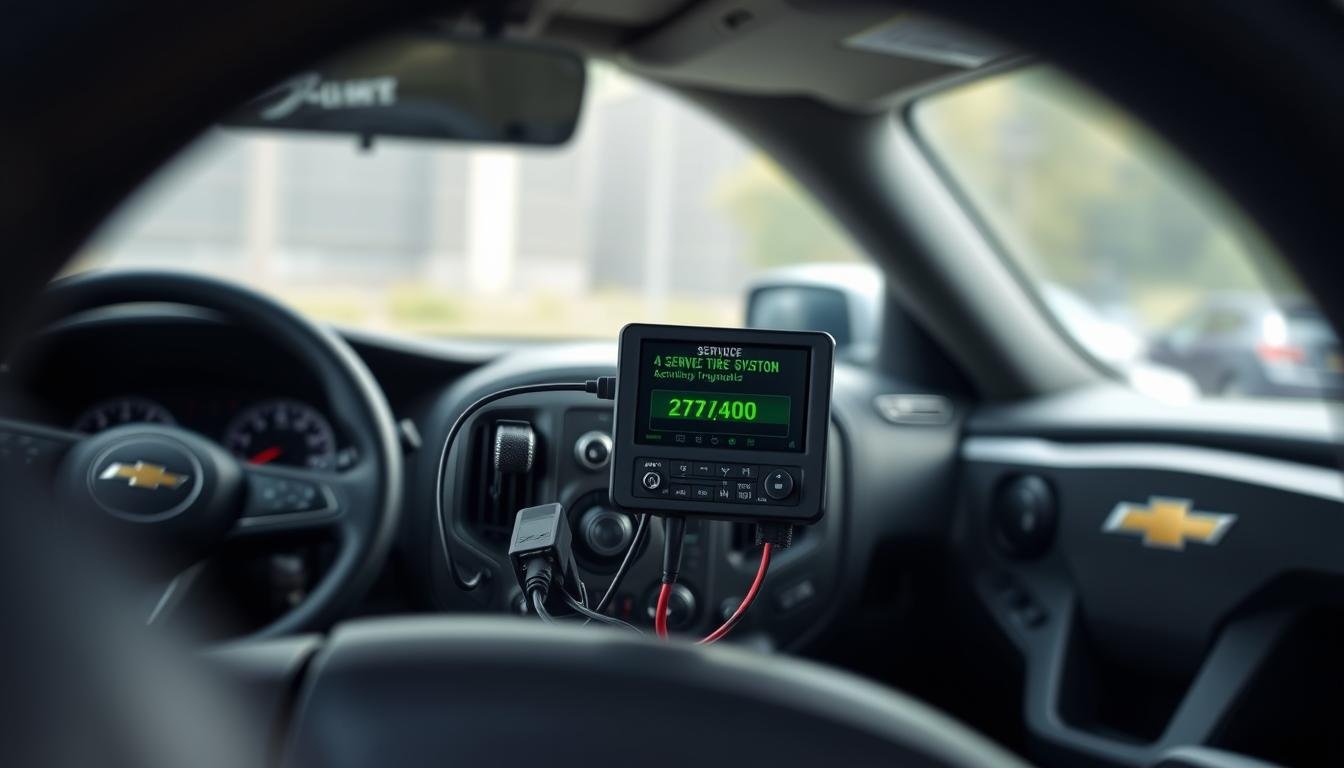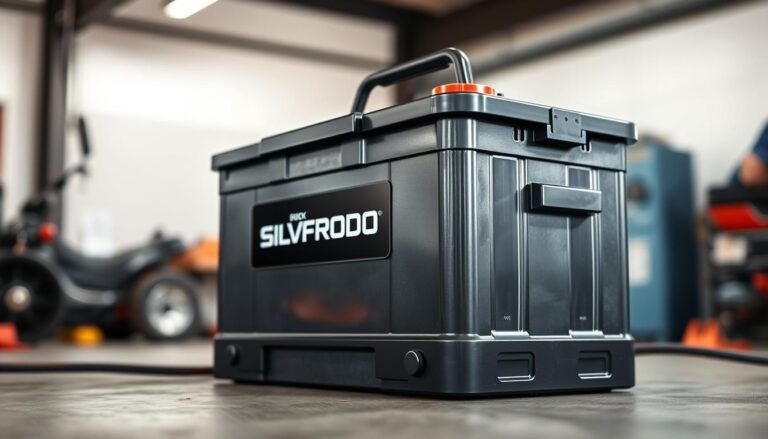Service Tire Monitor System Chevy: Quick Solutions
The Service Tire Monitor System (TPMS) in your Chevy is key to keeping you safe on the road. It tells you when your tire pressure is too low, helping you keep your car in top shape.
Whether you need to fix a TPMS alert fast or understand how to check your tire pressure, this guide has got you covered.
We’ll show you what the Chevy TPMS does, how it works, and how to avoid tire problems.
Knowing how the TPMS works helps you act fast if a warning light turns on. For example, every 1 PSI drop can lower gas mileage slightly.
And tires can lose around 1 PSI for every 10°F drop in temperature. That’s why it’s important to check your tires often.
Tire pressure sensors usually last 5 to 10 years, so keep an eye on them to keep your car running well.
This article tells you about the signs to watch for, how to fix issues, and when to see a pro.
What Is The Chevy Service Tire Monitor System?
The Chevy Service Tire Monitor System is also called the tire pressure monitoring system (TPMS).
It’s a key part of your vehicle, looking after the tires’ air pressure. It tells you if the tire pressure is too low or high for the best performance and safety.
Overview of Tire Pressure Monitoring Systems
Chevrolet cars have a tire pressure monitoring system. This system has sensors either inside or near the tires. These sensors talk to the display on your dashboard.
If tire pressure goes below 30-35 PSI, a light warns you. This helps stop serious tire problems and saves fuel.
Importance of the Service Tire Monitor System in Your Chevrolet
The Service Tire Monitor System is really important. If tires are not inflated right, you use more fuel. In fact, for every 1 PSI drop, you can lose up to 3% in fuel efficiency.
Keeping tires right can also improve fuel economy by up to 10%. Also, tires naturally lose 1-2 PSI each month. So, it’s good to use the Chevy TPMS to stay safe and save gas.
How It Works and Alerts You
The system has sensors that always check your tires’ air pressure. If pressure gets too low, you’ll see a warning on your dashboard.
Sometimes, if there’s a sensor problem, the light stays on even when the pressure is fine. If this happens, you might need a professional to check it.
Paying attention to these alerts helps your tires last longer and keeps you safer on the road.
| Feature | Details |
|---|---|
| Recommended Tire Pressure | 30-35 PSI |
| Fuel Efficiency Loss | Up to 3% per 1 PSI drop |
| Improvement with Proper Inflation | Up to 10% improvement |
| Tire Pressure Loss per Month | 1-2 PSI |
| Common Causes for Warning Activation | Low tire pressure, faulty sensors |
| Typical TPMS Reset Process | Check pressure, adjust as needed |
Why Is Proper Tire Pressure Important?
Keeping the right tire pressure is key for your car’s best performance and safety. It helps with how the car drives, uses fuel, and how long the tires last.
If the pressure is off, it can lead to safety risks and more expenses.
Effects of Low Tire Pressure on Vehicle Performance
Not enough air in your tires can cause problems. For each 1 PSI drop, fuel use can go up by 3%. Also, soft tires create more drag on the road.
This makes it tougher to control the car and increases the chance of tire damage. Driving on such tires can be risky.
Consequences of High Tire Pressure
Too much air in tires is also bad. It can make the ride bumpier and wear down the middle part of the tire faster. This means less control in bad weather.
Keeping your tire pressure just right improves how your car handles. It makes driving smoother and safer.
How Does The Service Tire Monitor System React?
The Chevy Service Tire Monitor System checks tire pressure. It uses dashboard lights to let you know what’s happening.
If tire pressure is off, you’ll get a warning to check your tires. Knowing what these signals mean helps keep your tires in top shape and safe.
Common Warning Signs You Might Encounter
While driving or starting your car, you might see different TPMS warnings. It’s vital to heed these warnings to prevent tire troubles:
- Steady TPMS light: Indicates tire pressure is significantly below the recommended level.
- Flashing TPMS light: Signifies a malfunction in the tire pressure monitoring sensors.
- Individual tire pressure readouts: Available in newer models for more precise monitoring.
- Dashboard notifications: Additional alerts that may inform you about other tire-related issues.
Types of Alerts Generated by The System
The Tire Pressure Monitoring System sends various alerts about your tires. Here are the alerts you might get:
| Alert Type | Description |
|---|---|
| Low Tire Pressure Alert | Triggered when tire pressure drops 25% below the set level, indicating potential under-inflation. |
| Sensor Malfunction Alert | Appears if the system detects an issue with any of the monitoring sensors. |
| Tire Pressure Update | Regular updates from direct TPMS that continuously check and report tire conditions. |
| Inconsistent Tire Pressure | Alerts you when pressure varies among tires, which may lead to poor vehicle handling. |
Common Reasons For Service Tire Monitor Issues
The Service Tire Monitor System is key for keeping your tires at the right pressure in your Chevrolet. It’s important to know about common TPMS problems for your vehicle’s safety and efficiency.
Things like changes in the weather, broken sensors, and tire pressure dropping due to use are big reasons for issues.
Taking care of these problems quickly can make your tires last longer and work better.
Low Tire Pressure Due To Real-World Conditions
Most times, tire pressure goes down because of small leaks and the environment. If a tire’s pressure drops by 1 PSI, your car uses about 3% more fuel.
Also, tires lose around 1 PSI with every 10°F drop in temperature, which might turn on warning lights when it’s cold.
Knowing this helps you check your tires at the right time to prevent damage or a tire popping.
Faulty Tire Pressure Sensors and Their Impact
Busted tire pressure sensors are a big problem for TPMS because they usually work for 5 to 10 years. They might stop working one at a time, giving wrong pressure numbers.
Around 20% of TPMS troubles come from sensor batteries dying, blocking correct pressure info.
Checking sensors often helps find and fix problems before they mess up your tire pressure readings.
Seasonal Temperature Changes Affecting Tire Pressure
Temperature changes really impact tire pressure, especially with the seasons changing.
These shifts in temperature can make your tire pressure go up or down, affecting how safe and smooth your car drives.
It’s key to keep an eye on your tire pressure when the temperature changes a lot. Making sure your TPMS is set right helps keep the pressure correct and your tires working well.
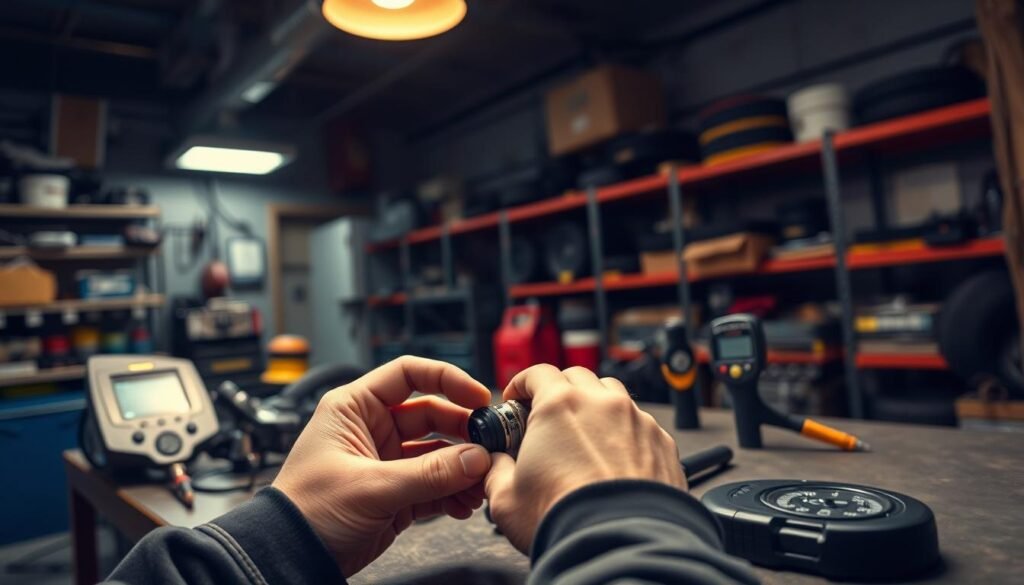
Diagnosing Problems with Your Chevy Service Tire Monitor System
To diagnose TPMS issues in your Chevy, start with a detailed inspection and watchful observation. Make sure to check the tire pressure readings.
Compare them with what the maker says they should be. A big difference might mean there’s an issue with sensors or the pressure isn’t right.
Identifying Faulty Sensors or Misaligned Pressure
To find out if a tire sensor is not working right, you should:
- Use a trustworthy tire pressure gauge to get accurate readings.
- Check these readings against the pressure your owner’s manual suggests.
- Look for any differences in pressure between tires, which could mean a sensor is off.
- Visually check the sensors for signs of damage or rust.
- If needed, get a professional to check if the sensors are working as they should.
Inspection Techniques For Tire Damage
Checking your tires regularly is key to keeping your TPMS working well. To do this, you should:
- Regularly check how deep the tire tread is, as low tread can mess up performance and readings.
- Look for wear patterns that aren’t even, as they can mean your car’s alignment is off.
- Check for any holes or cuts since these issues can make tires lose air and set off TPMS warnings.
- Always keep an eye on your tire pressure, both monthly and before any long trips.
Service Tire Monitor System Reset: A Step-by-Step Guide
To keep your vehicle safe, resetting the Chevy TPMS is important. This guide shows you how to refresh your tire pressure system after any maintenance. Just follow the steps and use the right tools to reset the TPMS correctly.
Tools Required For Resetting The TPMS
- Tire pressure gauge
- Air compressor
- Owner’s manual
How To Refresh The System After Maintenance
Start by checking the tire pressures with a tire pressure gauge. Inflate each tire to the proper pressure, found in your owner’s manual or on a sticker inside the driver’s door.
Then, drive your Chevy briefly. Driving helps the system to recalibrate and ensures the refresh of your tire pressure system.
If your TPMS still shows errors, you might need to use the TPMS reset button. Usually found beneath the steering wheel or in the glove box, press this button until the indicator light blinks.
This signals a successful reset. Doing this recalibrates the tire sensors to show accurate readings.

| Step | Description |
|---|---|
| 1 | Check tire pressures with a gauge. |
| 2 | Inflate tires to recommended levels. |
| 3 | Drive a short distance to refresh the system. |
| 4 | If needed, press and hold the TPMS reset button. |
Preventive Maintenance Tips For Your Chevy Tire Monitoring System
Keeping your Chevy’s tire monitoring system in check is key for great car performance and safety.
By following preventive tire monitoring advice, you can boost both your tires’ and the tire pressure monitoring system’s (TPMS) lifespan.
Checking tire pressure regularly and rotating them on time is crucial.
Regular Checks For Tire Pressure
Check your tire pressure every month to keep them inflated as the maker suggests. This action is good for your tire’s performance, saves gas, and keeps you safe on the road.
Here’s how to check your tire pressure:
- Use a dependable tire pressure gauge.
- Inspect all tires, including the spare, when they’re cool.
- Update pressures to match the recommended PSI.
Research shows 75% of cars have at least one tire not fully inflated, affecting handling and safety. Regular checks keep these issues at bay.
Tire Rotation and its Benefits For TPMS
Tire rotation is also crucial for your TPMS. Doing it every 7,500 miles helps tires wear down evenly and last longer. Tire rotation helps with:
- Avoiding early tire wear and increasing safety.
- Keeping the tread depth the same on all tires for smoother driving.
- Keeping TPMS readings accurate by maintaining steady tire pressure.
If you don’t rotate tires correctly, your TPMS might not work right. This can lead to wrong pressure readings and safety risks.
Keeping to a rotation schedule helps avoid these problems and maximizes your Chevy’s tire monitoring system benefits.
Service Tire Monitor System Chevy: Quick Solutions
Getting alerts from the Service Tire Monitor System is key to your car’s safety and how well it drives. Many issues can be fixed quickly.
This might mean checking tire air levels or looking for tire damage. Looking after these alerts early stops bigger problems later.
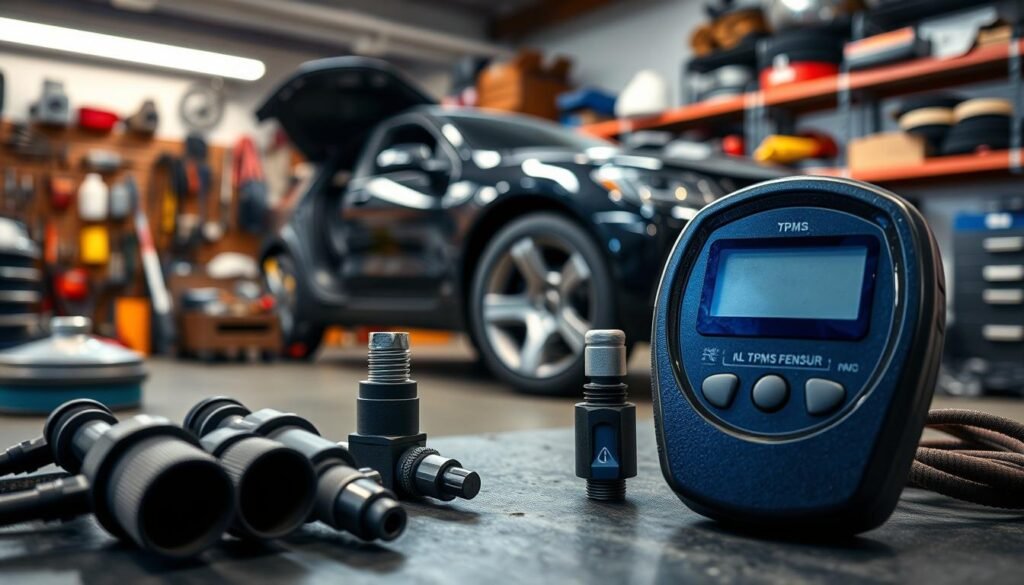
Quick Fixes For Common Alerts
If your Chevy’s tire light comes on, try these fast steps:
- Check and inflate tires to the right air pressure.
- Look over tires for any damage or wear signs.
- Reset the tire pressure monitor after you adjust pressure.
- Make sure valve stems are leak-free and not blocked.
Doing these things might fix small alerts, letting you drive with confidence again.
When To Seek Professional Help
If lights stay on after you’ve tried quick fixes, it might be a bigger problem. It’s time to get professional help if this happens. Here’s when to see an expert:
- Warnings keep coming even after fixing tire pressure.
- If you think a sensor isn’t working right, giving bad readings.
- When tire pressure drops for no reason or there’s tire damage you can’t explain.
Going to a certified service center for your Chevy’s tire monitor issues means getting correct fixes. This keeps your car safe and working right.
The Role of Temperature Changes on Tire Pressure
Temperature is key in keeping the right tire pressure. When it gets colder, your tire pressure goes down. This can change how well your vehicle performs.
Knowing how temperature affects tire pressure helps keep your tires just right. This is especially important in the winter, when it gets really cold.
Adverse Effects of Cold Weather on Tire Performance
When the weather gets colder, tire pressure drops a lot. For every 10°F decrease, tires lose about 1 psi. This can cause blowouts.
Low tire pressure affects fuel use, braking, and handling. If pressure drops to 75% of what it should be, a warning light turns on. This means you need to check your tires right away.
Checking your tires regularly in cold months is crucial. Keeping the right pressure boosts performance and tire life.
How To Adjust to Seasonal Weather Changes
It’s vital to adjust tire pressure as temperatures change. Here are tips for cold weather:
- Check tire pressure often, at least once a month, or before long trips.
- In cold weather, add 3-4 psi more than the recommended amount, especially if inflating indoors.
- Know your local weather trends to prepare for tire pressure adjustments.
- Think about filling your tires with nitrogen. It keeps pressure stable longer than air does.
Staying ahead of how temperature changes affect tire pressure keeps your car running well in winter. This ensures your vehicle is dependable and safe.
Learning The Cost of TPMS Maintenance
Maintaining your Chevy’s Tire Pressure Monitoring System (TPMS) involves costs that keep your car running well. Knowing these costs helps you plan your spending.
Sensor replacements, recalibration, and checks are common expenses. Regular maintenance helps avoid big problems and makes your system last longer.
Typical Expenses Related To TPMS Repairs
The cost of fixing your Chevy’s TPMS can vary. How often and what kind of repairs you need matter a lot. Here’s a brief look at what you might pay for common TPMS repairs:
| Service | Average Cost |
|---|---|
| TPMS Sensor Replacement | $40 – $150 per sensor |
| Relearning After Sensor Replacement | $20 – $50 |
| Electrical Diagnostics | $50 – $150 per hour |
| Tire Rotation and Maintenance | $20 – $50 |
Cost-Effectiveness of Regular Maintenance
Keeping up with your TPMS maintenance is smart. It helps catch problems early, saving you money on big repairs later.
For example, a quick check can stop you from needing to replace sensors due to electrical issues.
With a good TPMS, your tires last longer and your car uses less gas. This means you spend less on keeping your car in shape.
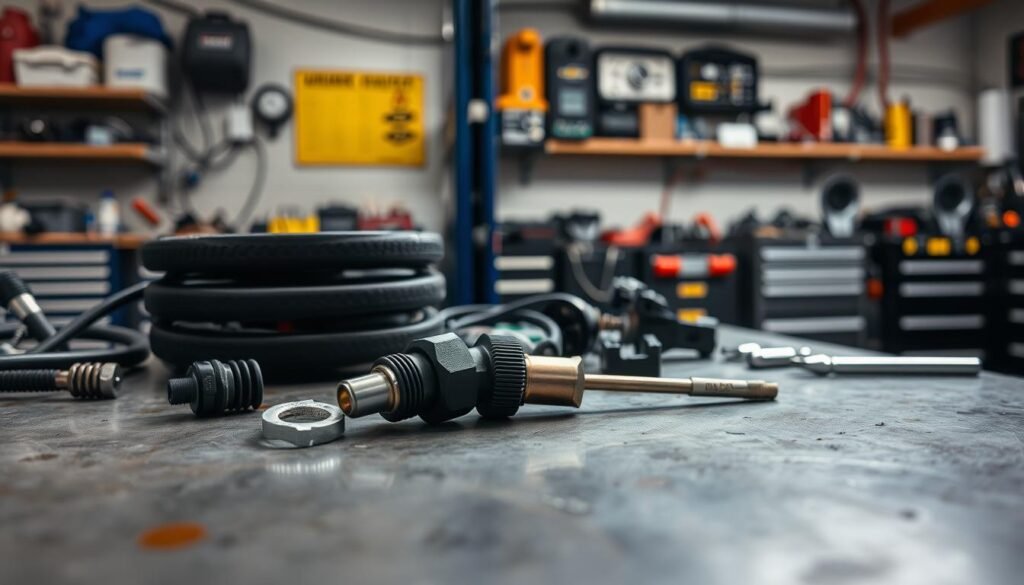
Maximizing The Life of Your Tires with TPMS
It’s crucial to keep your tires in top shape for safety and to make your vehicle last longer. Keeping up with tire care is key.
Regularly checking tire pressure, rotating them, and getting new ones when needed can improve your drive.
Best Practices For Tire Care
- Check tire pressure monthly and before long trips.
- Rotate tires every 5,000 to 7,500 miles to promote even wear.
- Replace tires when tread depth is below 2/32 of an inch.
- Store tires in a cool, dry location away from direct sunlight when not in use.
- Inspect tires regularly for signs of damage or wear.
Benefits of Keeping Your System Functioning Properly
A well-maintained Tire Pressure Monitoring System (TPMS) brings many safety and performance benefits. The TPMS checks tire pressure every 30 seconds when not moving.
It warns you quickly if a tire loses pressure fast. Taking care of your TPMS and tires prevents problems, saves gas, and improves the way your vehicle handles.
Remember, if tire pressure drops by more than 1.2 psi, the TPMS updates its reading right away. After putting air in your tires, drive for at least 30 seconds.
This lets the system update the pressure reading. By doing these things, you drive safer, avoid tire troubles, and have a dependable car.
Conclusion
The Chevy Service Tire Monitor System is vital for your car’s safety and how well it drives. It helps you prevent tire problems.
Keeping your tires at the right pressure, like 35 PSI for a Chevy Equinox, makes driving better and prevents dangers like tire blowouts.
It’s important to regularly check your tires, adjust when needed, and keep up with their care. Ignoring your car’s TPMS warning can lead to expensive fixes and risks.
Replacing a TPMS sensor can cost between $100 and $150. So, keeping your tire system in check saves money and makes drives better.
Taking care of your TPMS means your car uses less gas, your tires last longer, and you’re safer on the road.
This article gives you tips to manage your tire system well. This ensures your car always performs its best.
FAQs
What does the Chevy Service Tire Monitor System do?
The Chevy Service Tire Monitor System keeps an eye on your tire pressure. It lets you know if the pressure gets too low or too high. This helps you drive safely.
How can I reset the Chevy tire monitoring system?
To reset the system, first make sure your tires have the right amount of air. Then, drive a little bit to let the system update. If you still have issues, look at the TPMS reset steps in the manual.
What are common reasons for my tire monitor system warning light to activate?
Low tire pressure, bad sensors, and changes in the weather are common issues. These can make your tires lose air.
How often should I check my tire pressure?
You should check your tire’s pressure every month or before long drives. This keeps your car running well and safely.
What is the average cost of TPMS maintenance?
TPMS upkeep might cost you in sensor replacements and recalibrations. But, keeping your tires in check prevents bigger, costly problems.
Can temperature changes really affect my tire pressure?
Yes, weather changes can drop your tire pressure. For every 10°F decrease, your tires might lose 1 psi. This could lead to flat tires.
When should I seek professional help for my tire monitoring system?
If your warning light won’t go off or you think there’s a sensor issue, see a pro. They can figure out what’s wrong.
How does proper tire maintenance affect the Chevy tire pressure monitoring system?
Looking after your tires means checking pressure and rotating them regularly. This keeps your TPMS in good shape, making driving safer and smoother.

